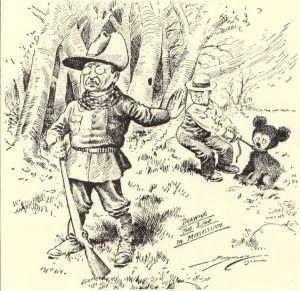
The American Teddy Bear Story
President Theodore “Teddy” Roosevelt loved to hunt. It was no secret. So in November 1902 when he visited Mississippi to settle a border dispute between Mississippi and Louisiana, it was only natural that Mississippi Governor Andrew Longino would take him bear hunting in the Mississippi Delta. However, no bears were to be seen for a long time. Finally his host’s guides captured a black bear and tied it to a tree for the President to shoot. President Roosevelt, however, thought it unsportsmanlike to shoot the bear and refused. He did, however, instruct that the bear be put out of its misery.
Political cartoonist Clifford Berryman, hearing about the incident, drew a cartoon titled “Drawing the Line in Mississippi” that appeared in the Washington Post on November 16, 1902. The first cartoon showed a grown bear, but later editions showed a cute bear cub.
In New York, the cartoon was seen by Russian Jewish immigrants Morris Mitchtom and his wife Rose who, in addition to owning a candy store, made their own stuffed toys to sell. After seeing the cartoon, unaware of what was going on in Germany at approximately the same time, the Mitchtoms decided to make two plush bears in honor of the President. They put the bears in the window of their candy store with the label “Teddy’s bears.” The bears were an instant hit. Unfortunately, no records exist that give the exact date.
Stunned by the bears’ popularity Mitchtom wrote to President Roosevelt, enclosing a bear, and asking if he could name the bears after him. President Roosevelt agreed. And so “teddy bears” were born.
Teddy bears helped Theodore Roosevelt during his reelection campaign for a second term in office. In 1905 Writer Seymour Eaton wrote a serialized story titled Roosevelt Bears featuring Teddy-B and Teddy-G and their adventures as they crossed the United States by train. The newspaper serial was later published as four children’s books that are still popular today. And teddies even had their own song, The Teddy Bear Two Step by J. W. Bratton (1907) that, with the addition of words by Jimmy Kennedy in 1932, became popular as The Teddy Bears’ Picnic.
More teddy bears followed as the teddy bear craze mounted. So many so that the Mitchtoms gave up their candy store to make the new toy. By 1907 the demand was so great they opened a manufacturing plant which became the Ideal Novelty and Toy Company (later just simply the Ideal Toy Company).
In the meantime, partly due to the demand and partly to the number of teddy bears being shipped to the United States from Germany, American teddy bear manufacturers began to open and soon teddy bears were enchanting children everywhere.
Early teddy bear charmers were made by companies such as Aetna, Bruin, and Gund. However, only a few of these early American teddy bear makers lasted very long, perhaps only a year or two; of these, only Ideal (now part of Mattel) and Gund still survive. But other companies took their place, fueled by the demand for the bears. The newer ones included the North American Bear Company, Boyds Bears, and Vermont.
A new teddy bear emerged in 1996 to claim a place among children’s treasures—Build-A-Bear teddy bears. In Build-A-Bear Workshops children (and adults) make their own teddy bear on site. There’s even a birth certificate for the teddy bear! It’s wonderful to see the delight in new owners’ eyes as they plan their new teddy bear and then supervise its construction until it’s ready to be adopted and taken to its new home.
Although teddy bears continue to be mass produced, especially in the Far East, the craft of making teddy bears by hand continues not only with such classic teddy bear manufacturers as Steiff and Gund, but also by “teddy bear artists.” This trend was started in in 1974 by American Beverly Port, a doll maker who took a teddy bear to a doll show. And the rest, as they say, is history.
Not only are teddy bears often included in doll shows, teddy bears artists sprang up everywhere. These bears tend to be more for adult humans than children, but have no trouble finding homes. For teddy bear artists put love and care into their teddy bears that mass produced bears don’t receive.
Teddy bears come in all shapes and sizes, big and small, cute and sad, young and old. They comfort us and share our adventures. But they all touch our hearts in one way or another that says, “Buy me!” And buy them we do, and will continue to do so.
